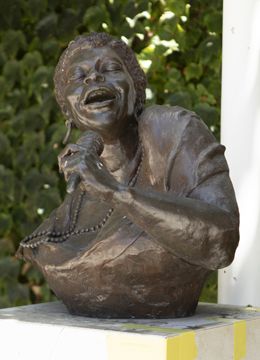»Ella Fitzgerald Bust
- Ella Fitzgerald
Critical Essay By
Mildred Lewis
Assistant Professor of English
Wilkinson College of Arts, Humanities, and Social Sciences
View Bio
Swing music. It’s what celebrated jazz vocalist Ella Fitzgerald was best known for. Sculptor Miriam Lodder (Baker) has captured its rhythms in the curve of Ms. Fitzgerald’s pearls. The singer is depicted open mouthed, her earrings dangling, possibly scatting her smash hit “A-Tisket, A-Tasket.” The bust is clearly meant to communicate the pure joy and power of her artistry.
Dubbed the First Lady of Song, Fitzgerald had extraordinary success. She sold over 40 million records and was the dominant female jazz singer in the world for more than a generation. Her accolades included the National Medal of Arts and multiple Grammy awards.
Commissioned by Richard and Hyla Berta, this piece was unveiled in 1998 two years after the singer’s death. It reflects Chapman’s commitment to public art and to music. Chapman’s Choir under the leadership of Dr. William D. Hall, for example, had earned renown in the 1993 hit movie Sister Act: Back in the Habit. But Fitzgerald never visited campus and had no known associations with Chapman. How, then, can her life speak to Chapman’s identity? What can her monument mean to today’s Panthers?
The inscription on the bust, “I sing what I feel,” begins to answer these questions. Fitzgerald literally made herself up out of almost nothing. After her mother’s death, she eventually landed in a reformatory. She escaped to Harlem at 15-years-old, penniless and alone during the Great Depression. In 1934, she won an amateur contest at the Apollo Theater. By 1935 she had begun touring with Chick Webb’s orchestra. Her career remained on an upward trajectory for the rest of her life. She was an artist who felt things deeply and expressed those feelings in songs that reached across the globe.
Fitzgerald’s life has parallels to Chapman’s history. An Orange County Register article, “How Chapman University ascended in stature,” noted that in 1975:
Things were going bust over at Chapman College. Paintings and Persian carpets were being auctioned off. Houses purchased for future expansion were being unloaded at fire sale prices. Faculty members were taking pay cuts. [T]he oil crisis, along with enrollment and tuition problems had nearly put the small college into bankruptcy. (November 4, 2007)
In this great stylist’s work, profound suffering was joined to expert craft and turned into great art. Her elegance and versatility were fueled by a stark awareness of what it takes to fight your way back from devastating setbacks. During difficult times, it is important to remember that resilience is also built into Chapman’s DNA.
It is important that Chapman has busts of both Dr. Martin Luther King, Jr. and Ella Fitzgerald. Fitzgerald broke racial barriers in entertainment, while Dr. King advocated for policy and legislation. Both efforts were needed then. Both are needed now. Entertainment has a unique contribution to make. It breaks down the walls that make us strangers to and, therefore, sometimes dangerous to one another.
Fitzgerald was the first African American performer in several venues including the Mocambo, a celebrated West Hollywood night club. While that is an easy sentence to write, it obscures the fact that she encountered hostility and threats for her efforts. She also could not and did not do this alone. The Mocambo appearance happened in part because Marilyn Monroe intervened on Fitzgerald’s behalf. She showed up for every night of Fitzgerald’s run. That sounds a lot like the allyship and cooperative spirit that characterizes so much of Panther life.
Fitzgerald also took on Norm Granz as her manager. Granz was well known for his support of civil rights. His battle to desegregate Las Vegas hotels and casinos is only one example of his commitment. Granz and Fitzgerald remained partners throughout her entire career. Ms. Fitzgerald’s civil rights efforts were recognized with the Equal Justice Award from the NAACP, the National Association for the Advancement of Colored People.
While Fitzgerald never sang a note here, her music has been played on campus many times over the years. Her legacy works in tandem with that of Dr. Martin Luther King, Jr.’s who also has a bust at Chapman. The 32-year-old minister spoke in Chapman’s Memorial Hall in 1961. A few days after his speech, he was arrested in Georgia. It took courage to bring Dr. King to campus at a time when he was being vilified. It was less controversial, but still a powerful statement to publicly honor Ella Fitzgerald. One can argue that there is a direct connection between this beautiful, dynamic bust and the presence of the Cross-Cultural Center, area, ethnic and Peace Studies programs, Rodgers Center for Holocaust Education, and the Schweitzer papers.
Chapman is far from perfect. But Ella Fitzgerald’s bust should encourage everyone who visits the Orange campus to remember that greatness doesn’t require perfection, but unending efforts towards it. The building blocks for her legacy are woven into our curriculum which requires the study of art, citizenship/community/service, ethics/values, and service. Not every university does.
The power of music is immense. It inspires and creates community in ways that nothing else can. A beautiful voice can reach directly into our souls. Ella Fitzgerald did that, but she was no radical. She simply stood as firmly for justice and equality as she did for excellence and creativity. That same spirit runs throughout Chapman’s history.
Her bust might be passed by dozens without a glance each year. But when they do notice, they will see a mirror of what Chapman has been and can yet become.
Collection of Historical Figures Map

Dedicated
March 29, 1998
Sponsor
George and Julia Argyros
Designation Name
The Bertea Family Chair in Music
Sculptor
Miriam Lodder
Campus Location
Aitken Arts Plaza, Orange Campus